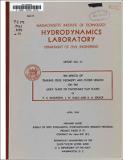| dc.contributor.author | Eagleson, P. S. | en_US |
| dc.contributor.author | Daily, J. W. | en_US |
| dc.contributor.author | Grace, R. A. | en_US |
| dc.date.accessioned | 2022-06-13T13:07:52Z | |
| dc.date.available | 2022-06-13T13:07:52Z | |
| dc.date.issued | 1962-04 | |
| dc.identifier | 51 | |
| dc.identifier.uri | https://hdl.handle.net/1721.1/142990 | |
| dc.description | Prepared under Bureau of Ships Fundamental Hydromechanics Research Program, Project S-R009 01 01 Contract no. NONR-1841 (21) | en_US |
| dc.description.abstract | This report presents the results of an investigation of the average and fluctuating two-dimensional structure of the early wake of fixed, flat plates at zero mean angle of attack as a function of trailing edge configuration and chord length. The experimental program provides for the measurement of the distribution of local mean velocity, static pressure, longitudinal velocity fluctuation and the spectral distribution of the kinetic energy of this turbulence component. The investigation was carried out in the 7-1/2" x 9" test section of an open-circuit water tunnel in the MIT Hydrodynamics Laboratory. An average free stream velocity of approximately 9.5 feet per second and plates of 1/h-inch thickness were used. All measurements were made between 1.50 and 9.75 plate thicknesses downstream of the trailing edge of the test plates, and between 0 and 2.80 plate thicknesses from the longitudinal plate centerline. Plate chord lengths used were 2" and 7". A primary aim of this study is the explanation of the vibrational behavior of the same test plates as found in a previous investigation. An attempt is made, wherever possible, to draw together the related facets of both studies. Information from both investigations is combined to infer certain characteristics of the vortex street and these characteristics are compared with those found by other investigators for bodies of various shapes. The primary conclusions to be drawn from the experiments on these particular plates are: 1. Downstream increase of wake width, for a plate of given trailing edge, is suppressed to a distance dependent upon the boundary layer thickness at the trailing edge. 2. At a plate thickness Reynolds number, It = 1.8 x 10h, transition between the inertial and viscous zones of wake development takes place at approximately x/t = 3.25. 3. With distance in the downstream direction there is an increase in the transverse spacing, h, of the discrete vortices in the wake. 4. The plate thickness Strouhal number varies with trailing edge configuration at a given Reynolds number. 5. The mean drag coefficient decreases as the trailing edge becomes more tapered. 6. The strength of the discrete vortices at a given station in the early wake becomes greater as the trailing edge becomes more tapered. 7. For a plate of given thickness and trailing edge geometry an increase in chord length reduces the frequency of vortex shedding. 8. The proportion of the total wake vorticity which is concentrated in discrete vortices increases with increasing chord length Reynolds number. 9. An increase in chord length decreases the intensity of turbulence, increases the mean velocity defect and decreases the pressure recovery at a given station in the early wake. 10. For constant chord length, the amplitude of plate vibration when pivoted at the leading edge increases with increasing vortex strength and with decreasing mean drag coefficient (both quantities determined with stationary plate). 11. Barring self-excitation of the plate motion, the frequency of plate vibration is precisely that at which discrete vorticity is shed into the wake from the stationary plate. | en_US |
| dc.publisher | Cambridge, Mass. : Hydrodynamics Laboratory, Dept. of Civil Engineering, Massachusetts Institute of Technology | |
| dc.relation.ispartofseries | R (Massachusetts Institute of Technology. Department of Civil Engineering) ; 62-19. | |
| dc.relation.ispartofseries | Report (Massachusetts Institute of Technology. Hydrodynamics Laboratory) ; no. 51. | |
| dc.title | The Effects of Trailing Edge Geometry and Chord Length on the Early Wake of Stationary Flat Plates | en_US |
| dc.identifier.oclc | 4306006 | |
| dc.identifier.aleph | 247447 | |
